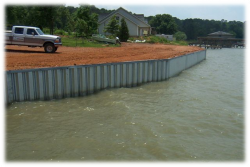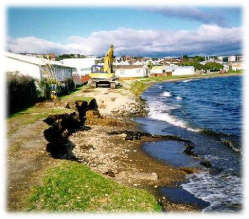Utilizing MATLAB For the Aid In Preliminary Design of Seawalls
Seawall Purpose
The main function of seawalls is to prevent (offshore beach) and shoreline erosion. The main mechanism for shoreline erosion is the relocation of materials. This is achieved by the rising and falling of the water level. In general, sediment is removed from the beach or shoreline and relocated elsewhere. While this may not seem like a big deal, it becomes very problematic for public beaches and especially areas where public or private structures are located. Many coastal areas around the country experience coastal erosion. Major cities like New York City, Boston, Miami, Seattle and Chicago all utilize seawall structures to help prevent erosion from their shorelines. On a more local scale, Lake Michigan in Milwaukee, WI experiences a lot of coastal erosion. Much of the shoreline in this area is dominated by bluffs. Although they are very scenic and beautiful from the land and the water, they are becoming more of a problem for home and land owners. Every year, a small portion of the shoreline erodes away. This is an example of why proper seawall design is so important. Below are some pictures of shoreline erosion encroachment towards structures.
Seawall Classification
The are two main types of seawalls. One, surprisingly enough, is seawalls, while the other type is bulkheads. Although these structures serve the same purpose, they do have one main difference. Seawalls are used to protect coastlines from erosion due to waves in seas or oceans. Bulkheads also prevent shoreline erosion, but on a much smaller scale. They are generally built on lakes, rivers and ponds and do not require materials that are as large and strong as materials for seawall design.
To give you a better idea of what a seawall looks like, we have posted a link below for a great youtube video demonstrating the purpose for a seawall on the ocean coast.
http://www.youtube.com/watch?v=L4MdxqfzalA
To give you a better idea of what a seawall looks like, we have posted a link below for a great youtube video demonstrating the purpose for a seawall on the ocean coast.
http://www.youtube.com/watch?v=L4MdxqfzalA
Materials

Residential bulkhead
The picture found to the left is an example of a bulkhead built for residential purposes. Bulkheads are usually built using metal sheeting or other similar materials. This is because of certain properties like resistance to corrosion and high strength factors. Steel sheeting is also a cheaper option than reinforced concrete and easy to install when compared to reinforced concrete.
Reinforced Concrete

A lot of seawalls are made of reinforced concrete. These types of seawalls are primarily found along ocean or sea coasts. This is because these areas require walls that have higher strength capacities.
There are many other types of materials that can be used for the construction of seawalls and bulkheads. Wood, rocks/boulders, brick, and other natural materials can be used. The type of material being used for any particular project depends on the type of project being done, how much money is available, the desired duration of the project, aesthetic qualities and so on.
Locations
Obviously, seawalls and bulkheads must be located in areas near water, or with a coastline. Typically, seawalls are located on the coast of seas and oceans. Bulkheads are used on lakes, rivers and ponds. On a local scale, some small-scale wave walls are used in locations such as James Madison and Tenney Park. Also, a good example of a very picturesque wave wall would be on Lake Monona, at the Monona Terrace.


